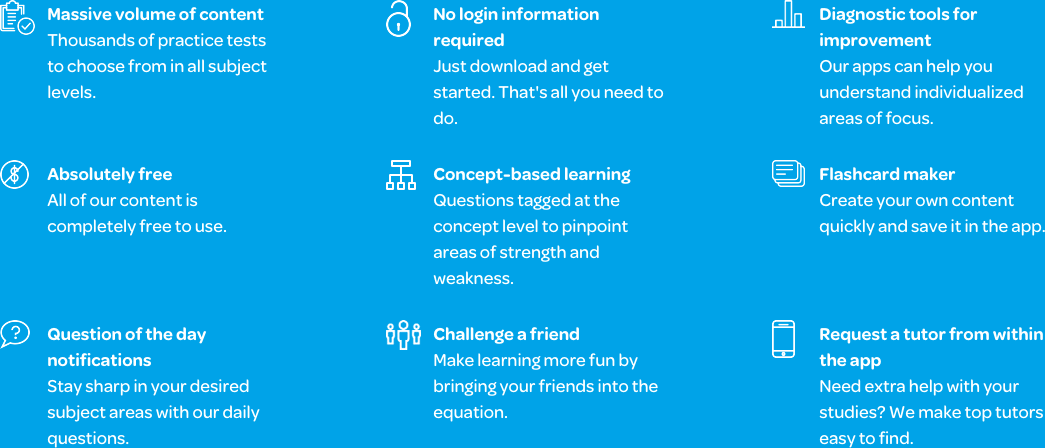The Varsity Tutors AP World History Mobile App
Spanning world history from about 8,000 BCE to the present day, AP World History offers a college-level look at the events, developments, and individuals that have shaped the progress of the world over six historical periods. The course is more than about memorization. You will have to use comparisons, valid arguments, and chronological reasoning to analyze events and processes. The five themes covered in the course include interaction between people and the environment; development/ interaction of cultures; state building/ expansion/ conflict; the creation, expansion, and interaction of economic systems; and how social structures are created and transformed. Students must make connections across time periods and distant regions. The Varsity Tutors AP World History app can help you understand the required content, keep up with the class, and prepare for the exam. It is available for iPhone, iPad, and Android on iTunes and in the Google Play Store.
The app includes several study tools to help make your AP World History study sessions productive. It offers Full-Length Practice Tests, which cover the major historical periods and regions. Each test consists of 70 questions, covering the full range of content you are likely to see on your AP exam. The format mimics the test. This preparation will help you be able to recall content under pressure and in the context of the test itself. With these practice exercises, you are immediately provided with feedback that isolates what you know from your weaknesses, which is a great tool to have ahead of the exam. You can also view how you scored compared to other test takers and track your accuracy and speed on each question. For each question, detailed explanations are provided at the end, and these can be used as study tools to help you master your problem areas.
Studying smarter, not longer, is often the key to succeeding in any advanced course. The app also includes shorter practice tests that focus on specific topics, letting you spend more time on the areas that are more challenging for you. From prehistoric Asia to literature, to 18th century events to the present day, the Learning Tools available will supplement your studies and help you quickly brush up on content. There are hundreds of shorter practice tests. You can also quickly run through related questions and study materials with the Learn by Concept interactive syllabus. This allows you to drill down from major topic areas to individual time periods and topics and focus on the areas tested on in the past. Similar to this format are the flashcards, which give you immediate answers and let you do brief overviews or continue on as long as you have time for. These are pre-made, but they can also be customized with your video, audio, or text on a smartphone.
The study review offered by the AP World History app can be as brief as you like. If your schedule is hectic, go for the Question of the Day, which selects a random question from the database of test items available. You’ll get an immediate response and can then return each day for a different topic. The content and the randomness of these and the Full-Length Practice Tests prepares you for the array of topics on the actual exam.
Your ability to understand historical context and compare events, causes and effects, and patterns of continuity will be critical during the three-hour, fifteen minute test. The AP World History app, available for iOS and Android, is here to guide you on the path towards success.
66 mobile apps to choose from for your tutoring needs.

Learn More
Advanced Placement (AP) World History is a comprehensive review of the evolution of human society. The focus of the course is on developing student comprehension of world history from about 8,000 B.C.E. to present. This is a college-level course that requires students utilize the same skills historians use to analyze the past, including analysis of primary and secondary sources, chronological reasoning, and creating historical comparisons. The five core themes of the course are the interaction between humans and the environment; state building, conflict, and expansion; development and interaction between cultures; creation, interaction, and expansion of economic systems; development of social structures and their transformations. While exploring these themes, students will learn to make connections between developments in different geographical areas and across time. Each of these themes can be studied with the help of Varsity Tutors’ AP World History app, available for free download from iTunes and the Google Play Store.
The total allotted time for the AP World History exam is 3 hours and 15 minutes. There are two sections of the test, each of which is comprised of two parts. The designated time for Section I of the test is 1 hour and 45 minutes. Part A of Section I is worth 40 percent of the exam grade. Students have 55 minutes to answer 55 multiple choice questions. Part B of Section I is worth 20 percent of the exam grade. Students have 50 minutes to answer four short answer questions. Part A of Section II is worth 25 percent of the exam grade. Students have approximately 15 minutes to read and review the provided document and 55 minutes to answer a question about that document. Part B of Section II is worth 15 percent of the exam grade. Students have 35 minutes to answer 1 of the 2 provided long essay questions. You can prepare with full-length practice tests that approximate the actual exam, as well as other study tools that drill down into specific topics, with the Varsity Tutors AP World History app for iPhones, iPads, and Android devices.
There are six specific concepts covered in AP World History. The first concept covers the technological and environmental transformations which occurred between approximately 8,000 B.C.E. to 600 B.C.E., and makes up 5 percent of the course. During this portion of the course, you will learn about the Paleolithic period when humans were migrating from Africa to the rest of the world. During this period, humans were learning to adapt to different geographical areas, developed technology, created social and political groups, and established trade.
At the end of the last Ice Age, agriculture began to develop independently around the world with the domestication of local plants and animals. These developments led to more complex social and economic systems. The more reliable supplies of food allowed the population to increase which provided an opportunity for people to specialize in specific fields. This created new classes such as artisans, warriors, and other elites. Technological innovations such as pottery, plows, woven textiles, wheels, and metallurgy emerged.
Beginning about 5,000 years ago, urban societies began to develop which allowed the first civilizations to form. While there are distinct differences between various civilizations, they share similarities such as the creation of an agricultural surplus, cities, political bureaucracies, religious hierarchies, armies, social hierarchies, and long-distance trade. As the wealth of the civilizations increased so did the instances of violence and war, which necessitated the development of war and defense technologies. Cultural achievements also grew to include art, language, literature, legal systems, myths, monumental architecture, and religion.
The second concept covers the organization and reorganization of human societies between 600 B.C.E. and 600 C.E., and makes up 15 percent of the course. As states continued to grow, contact between civilizations increased, and cultural and religious systems were transformed. Religious beliefs created a social bond and common ethical code which reinforced economic, occupational, and political stratification. Religious and political hierarchy frequently merged as rulers used religion to justify their rule, and enforced their rule with legal policies and military positioning. Belief systems began to cause conflict as they varied greatly between societies.
The number of large civilizations grew dramatically during this period as rulers began to impose rule on what had once been independent states. New methods of governance, trade, and social structures began developing in cultures around the world. Many of these grew beyond their ability to successfully manage and eventually declined, collapsed, or transformed into other states or empires.
The third concept covers the regional and interregional interactions between 600 C.E. and 1450, and makes up 20 percent of the course. During this period, improved transportation technology increased trade and expanded the geographical reach of major civilizations. The movement fostered further cross-cultural exchange in art, literature, science, technology, and cultural traditions. Agricultural production increased due to technological advances such as the chinampa field system, terracing, and the horse collar.
The fourth concept covers global interactions between 1450 and 1750, and makes up 20 percent of the course. During this period, connections between the civilizations in the Eastern and Western hemispheres began to form due to the advancement of transoceanic technologies such as the carrack, caravel, and fluyt. Trade patterns, known as the Columbian Exchange, facilitated the trade of religion, culture, crops, animals, and diseases. If this sounds like a lot so far, not to worry. Every concept in the course is covered in-depth by Varsity Tutors’ free AP World History app, which allows you to study from any location on your iPhone, iPad, or Android-powered phone or tablet.
Weather patterns began to change, which led to changes in agricultural technologies and practices. Plantations expanded and the demand for labor increased, which fueled the demand for products and raw materials. Social and political structures began to change, which further changed the racial, gender, and ethnic hierarchies in China, Europe, Spanish America, and Africa. During this time, empires began to expand tremendously as they conquered civilizations around the world. It was often difficult for these civilizations to successfully incorporate those they conquered, and new methods of power consolidation and legitimization emerged. Competition and conflict increased over trade routes and governance.
The fifth concept covers industrialization and global integration between 1750 and 1900, and makes up 20 percent of the course. During this period, industrialization significantly transformed the production of goods. This impacted social relations, the global economy, and world cultures. New trade patterns helped to further integrate the global economy, as more raw materials and new markets became necessary to sustain the new economies. Financial institutions and instruments were developed to protect and advance the new economic models being built. Advancements in transportation and communication such as railroads, steam- powered ships, telegraphs, and canals helped to develop and spread global capitalism.
Because of the restructuring of the global economy, societies underwent major changes as well. New social classes, family dynamics, gender roles, and urbanization all began to transform civilizations. Imperialism emerged and was supported by new racial ideologies such as social Darwinism. Nationalism, revolution, and reform became common as established governments clashed with new ideologies. Enlightenment philosophers such as Voltaire, Locke, and Rousseau further promoted the questioning of established traditions leading to major changes in global migration patterns.
The sixth concept covers global change between 1900 and present and makes up 20 percent of the course. This period has seen significant advances in science and technology which facilitated population growth at unprecedented levels. Global conflicts have also increased dramatically. New ideas concerning a global economy, the role of government, and the self- determination of individuals have been paramount.
At the end of the course, you will have a greater understanding of world events and how they helped shape history into the present. You should be able to outline themes and trends and answer questions about major civilizations and advancements of different historical periods. Most importantly, this course ensures you will develop the research and critical-thinking skills necessary for college courses. You can get started building these skills today when you download the free Varsity Tutors AP World History app from iTunes or the Google Play Store.




